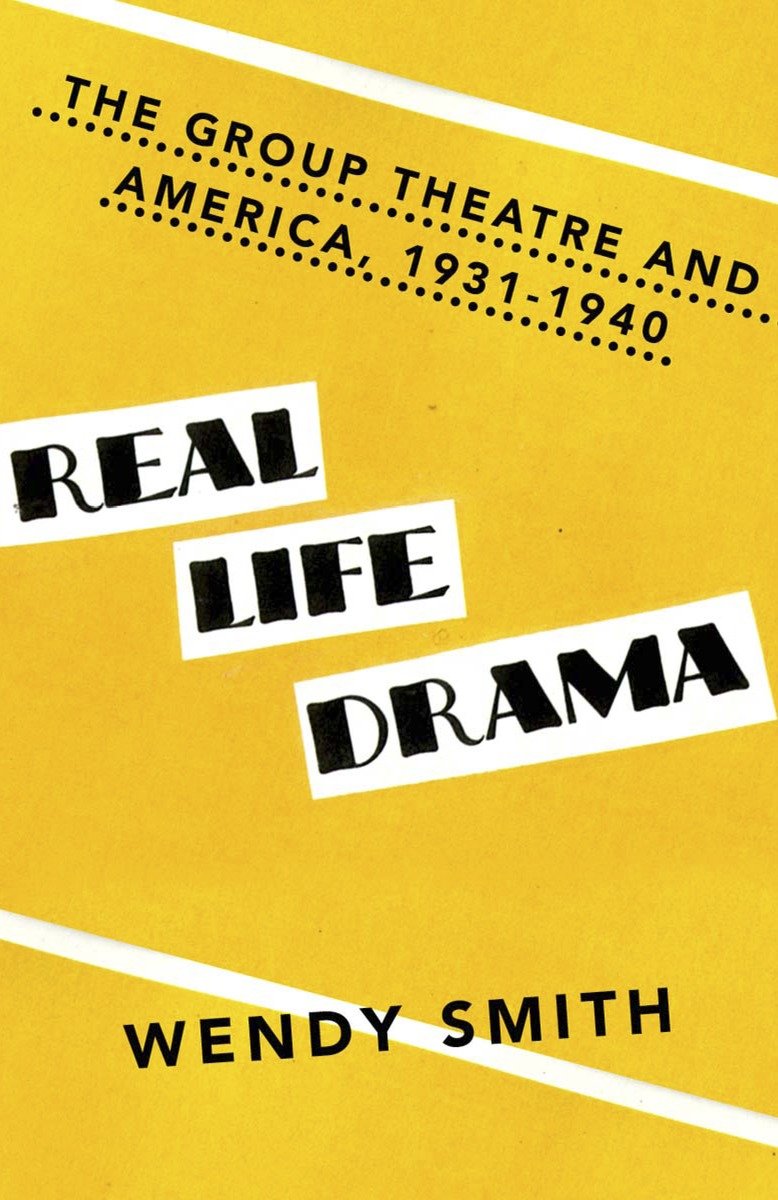Real Life Drama: The Group Theatre and America 1931-1940
17.00 JOD
Please allow 2 – 5 weeks for delivery of this item
Add to Gift RegistryDescription
Real Life Drama is the classic history of the remarkable group that revitalized American theater in the 1930s by engaging urgent social and moral issues that still resonate today. Born in the turbulent decade of the Depression, the Group Theatre revolutionized American arts. Wendy Smith’s dramatic narrative brings the influential troupe and its founders to life once again, capturing their joys and pains, their triumphs and defeats. Filled with fresh insights into the towering personalities of Harold Clurman, Lee Strasberg, Cheryl Crawford, Elia Kazan, Clifford Odets, Stella and Luther Adler, Karl Malden, and Lee J. Cobb, among many others, Real Life Drama chronicles a passionate community of idealists as they opened a new frontier in theater.
Additional information
| Weight | 0.62 kg |
|---|---|
| Dimensions | 3.56 × 15.5 × 23.5 cm |
| PubliCanadation City/Country | USA |
| by | |
| format | |
| Language | |
| Pages | 528 |
| publisher | |
| Year Published | 2013-8-6 |
| Imprint | |
| ISBN 10 | 0345805992 |
| About The Author | Wendy Smith is a contributing editor of The American Scholar. Her book reviews and author profiles appear frequently in The Washington Post, The Daily Beast, Newsday, Publishers Weekly, and other publications. She has contributed articles to American Theatre magazine and is a member of the League of Professional Theatre Women and the Board of Advisers of the ReGroup Theatre. |
"This is the coolest, most objective, most valuable book on the Group Theatre we will ever get." –Alfred Kazin"The Group Theatre was unique…. It was literally the voice of Depression America. Anyone interested in the Group has to know what is in this fine book." –Arthur Miller"Required reading on the development of modern American theatre. Dense with character, incident, ideas." –Library Journal |
|
| Excerpt From Book | ONEGenesisIn the beginning was the Word—a whole flood of words from a passionate idealist in search of a spiritual and artistic home.One Friday night in November 1930 Harold Clurman, a twenty-nine-year-old playreader with the Theatre Guild in New York City, began a series of weekly talks for an audience of young actors he hoped to interest in the theatre he wanted to establish with his friends, an actor-director named Lee Strasberg and the Guild’s casting director, Cheryl Crawford. When this quiet, stammering young man opened his mouth, out rushed an extraordinary monologue, the aggregate of everything he had ever thought, felt, hoped, and dreamed about American theatre and American life. When he paused for breath the following May, he had articulated a vision of a new kind of theatre: an ensemble of artists who would create, out of common beliefs and technique, dramatic productions that spoke to an equally committed audience about the essential social and moral issues of their times. By June, he and his two friends had set off for the country with twenty-seven actors who shared their determination to make that vision a reality.The talks began in Clurman’s room at the Hotel Meurice on West 58th Street. Soon word spread, the audience grew, and they moved to Cheryl Crawford’s larger apartment on West 47th Street. When that filled to overflowing, they persuaded other friends to play host. The photographer Ralph Steiner had to rent chairs from a nearby undertaker to seat the crowd; his guests were so broke they couldn’t reimburse him. Finally someone finagled a large room, rent-free, at Steinway Hall on West 57th Street, where as many as 200 people would come to listen to the weekly jeremiads.Part of the attraction was the spectacle of Clurman in full cry. A shy man who sometimes spoke so softly he could hardly be heard, he was transformed by his intense need to communicate his ideas. Whatever names people called Harold Clurman after 1930, they would never call him shy. “I changed by the challenge of life,” he later remembered. “I said, ‘I’ve got to get over this shyness! I’ve got to get them to be interested in what I’m saying! I know I’m right, by God I know I’m right!’ ” He seemed almost possessed: his face turned red, veins stood out, his once hushed voice rose to a pitch clearly audible outside in the street. He would grab the nearest chair, pick it up and shake it at his audience before flinging it aside. One of his most potent weapons was a willingness to make himself ridiculous, to exaggerate wildly, scream and stamp his feet to get a point across—in a ringing Bronx accent somewhat at odds with his almost mystical message. The set designer Boris Aronson once compared him to Father Divine, and there was certainly something evangelical in the way he laid out for his listeners the sorry state of the American theatre and exhorted them to do something about it.For if a few casual observers came once or twice to enjoy the show, those who returned week after week were drawn by Clurman’s provocative analysis of the artistic and social difficulties they faced and his stirring portrait of the theatre they could build together to solve their dilemma. He defined their vague dissatisfaction with the theatre and their work in it; he offered hope for the future. The actress Stella Adler summed up the call to arms that engaged her and so many others: “He said, ‘You are lost here. You won’t be able to find your way alone. Please follow me.’ ”Looking at the American theatre, Clurman saw an institution in such confusion that even its critics hadn’t really grasped what was wrong with it. He scornfully dismissed as superficial the conventional list of problems: a shortage of good plays, the personal vanity of actors, the moneygrubbing of commercial producers. “If we were providentially blessed with a host of admirable plays and players, and an epidemic of virtue broke out over the entire theatre-world, we should still hardly have effected the establishment of any sort of Theatre. . . . Nothing can be wrong with the theatre when no Theatre exists. And America has as yet no Theatre.”This was a bold statement. The 1920s had been the American theatre’s liveliest decade, crammed with glamorous stars, fired by the exciting emergence of native playwrights, vibrant with the rhythms of great popular music. On the surface, Broadway still boomed; despite the stock-market crash the previous October, there had been 249 productions during the 1929–1930 New York season. Even the majority of Clurman’s listeners who considered such quantitative measures trivial could point to Eva Le Gallienne’s success at the Civic Repertory Theatre, where she presented classical repertory at popular prices; to the Theatre Guild’s tasteful productions of European and American drama; to the careers of respected actors like Katharine Cornell, Alfred Lunt and Lynn Fontanne, who consistently appeared in classics and important contemporary plays; to the ongoing contributions of such patently serious writers as Eugene O’Neill, Maxwell Anderson, Elmer Rice, Sidney Howard, Paul Green, and John Howard Lawson. Surely these were proof that worthwhile theatre existed.Hardly, said Clurman. He was unimpressed by Broadway stars, unenthusiastic about their work in the classics, and doubtful that any existing organization could give adequate theatrical expression to the American dramatists he admired. His criticisms shocked many in his audience, yet in a fundamental way he was right, and they knew it. The American theatre was living off the dwindling artistic capital amassed in the heady years during and immediately after World War I, when an explosion of theatrical energy called the “little theatre” movement championed American playwrights, explored the possibilities of experimental theatre, and discovered an audience for serious drama. The little theatres had given a new vitality and credibility to American theatre, yet they had never comfortably made the transition from amateur to professional production; by 1930 such key organizations as the Provincetown Players and the Neighborhood Playhouse had folded and the movement itself seemed moribund. Its only lasting legacy in New York was the Theatre Guild, born from the ashes of the Washington Square Players in 1919 with a commitment to professionalism and, as its founding manifesto declared, to “the creation, as carefully and lovingly as lies within one’s power, of the best drama of one’s time, drama honestly reflecting the author’s vision of life or sense of style and beauty.”To Clurman, that sincere and high-minded credo was fatally flawed and indicated a misunderstanding of the basic problem that had killed the little theatres and still stood in the way of real theatrical growth. “The only fundamental difference between the new theatre and the old is that the former sells better stuff,” he declared rather cruelly. “These theatres always will begin with a play, and never with a group of actors that may be appropriately considered part of it. They will take a company of actors, usually trained in the petty realism of the average commercial play, and ask them to do French poetic-rhetorical drama, a modern German tragedy in the classic manner, or something equally foreign to them.” For actors like Morris Carnovsky, Franchot Tone, Phoebe Brand, Ruth Nelson, and Sanford Meisner, who had all worked at the Guild, this was a liberating insight, helping them understand why they had been disappointed by such well-intentioned productions as Jacques Copeau’s dramatization of The Brothers Karamazov and Franz Werfel’s Juarez and Maximilian, which in the end seemed stagey and without coherent intent.This lack of unity drove Clurman crazy. “We have, on the American stage, all the separate elements for a Theatre, but no Theatre. We have playwrights without their theatre-groups, directors without their actors, actors without plays or directors, scene-designers without anything. Our theatre is an anarchy of individual talents.”This was not the fault of the theatre so much as a reflection of a larger disorder in society. “Americans don’t really talk to each other,” Clurman told Cheryl Crawford around this time. “They make wisecracks to each other, they drink well together, but they don’t really exchange with each other their hearts, their backgrounds, their souls. They don’t really live together.” She was moved by his comment, and many of the listeners at Steinway Hall shared their profound disquiet with the way things were. It was symptomatic of a sea-change in the national spirit.To Clurman, the soulless materialism encapsulated in the word “Babbittry,” the smart-alecky cynicism of intellectuals who despised it, and the vague idealism of bohemians who looked to “art” as an alternative were all part and parcel of the anarchic individualism of the 1920s, an era in which self-fulfillment was the ultimate goal and the only disagreement was over the best way to achieve it. He and his colleagues were looking for something very different:We feel the individualism of self-assertion which made the ego the sole and final reality of life is self-destructive and we believe that the individual can realize himself only by seeking his spiritual kindred and by making their common aspirations and problems the object of his active devotion. We believe that the individual can achieve his fullest stature only through the identification of his own good with the good of his group, a group which he himself must help to create. . . . We do not know—we believe. We have not found, we are seeking. But we are seeking not in the texts of ancient creeds or in those of the up-to-the-minute intellectual academies but in the maze of our own lives, in the lives of those closest to us, in the ordinary routine of our work and our pleasures. We know that the task we have appointed ourselves is not simple and we expect our period of discovery to take a long time, so that our efforts will be a record of continuous growth. What we find our work will show. We are sure at least that we are not alone in anxious waiting.Words, words, and more words—every Friday night from the time the curtains went down on Broadway to the early hours of Saturday morning. Listeners who were too stirred up to sleep afterward repaired to Childs Restaurant on Columbus Circle to talk informally with Clurman. He held Sunday get-togethers, where an indignant young actress named Margaret Barker bombarded him with questions. “How dare you say these things about Lynn Fontanne?” she demanded, wondering plaintively why “all my gods had feet of clay for him.” Many wondered where all this talk was leading. An actor named Clifford Odets used to walk home with Clurman after the Friday meetings. One night he confessed, “You know, you’ve been talking for ten weeks, and I’m just beginning to understand you.” Clurman liked that; he didn’t believe in quick (or short) answers.Out of these rambling, impassioned lectures a picture slowly began to emerge of the kind of theatre the three aspiring directors wanted—for although Clurman was doing most of the talking, his ideas had been shaped over five years of discussion with Strasberg, and Crawford fully shared them:A theatre is created when people with common interests and tastes unite to devise ways and means whereby they may give their group feeling an adequate theatrical expression. They seek out people who, for all the superficial differences of their temperament, fundamentally share the same feeling. They seek them amongst directors, actors, playwrights, scene-designers—confident all the time that the thing that binds them together must be a reflection of a sentiment that animates many people in the world about them. . . . If the theatre is an art, if it has any value beyond decorating the emptiness of our existence, it too, collective art though it be, must have an analogous singleness of meaning and direction. It too must say something, it too must create from the chaos which is the common experience of its members, an expression that will have, like that of the individual artist, an identity and significance with which people, sharing the common experience, may sense their kinship and to which they can attach themselves.This was the difference between Clurman’s hoped-for theatre and existing organizations like the Theatre Guild and the Civic Rep, which were places to work rather than communities. No unifying principle informed these older companies: they had no organic connection with the material they performed, no point of view they wished to express through their work, no sense of the theatre as an arena in which important ideas could be thrashed out. They thought of theatre as an outlet for “art”; Clurman knew that real theatre was an expression of life itself.All very well, the more skeptical members of his audience said, but what were these important ideas—most crucial of all, what was this “Group Idea” to which Clurman kept referring? He hated to be pinned down: “Words are so inadequate for the definition of essences. You know Cheryl Crawford, Lee Strasberg and me. You have heard what we think about theatre; you have listened to our interpretation of plays, you know how we are attacking this project for a new theatre. In other words, you see us in action. If you are in sympathy with what we say and do, if your response is one of spontaneous affirmation, then you probably share our Idea. You have the first qualification for work in our theatre.”Some people were so infuriated by this vagueness that they stormed out of the meetings, never to return. But for many, Clurman’s fervent generalities struck a resonant chord. Though they might have little sense of what his broad pronouncements would mean in practice, they knew that the Group Idea in some way answered their individual hunger for a meaningful theatre and a committed life. Some knew more: they had attended the American Laboratory Theatre, where Clurman and Strasberg had studied the acting and directing techniques employed at the Moscow Art Theatre, or worked on the two plays they rehearsed for seventeen weeks in 1928, or spent time hanging around with them in the corridors of the Guild and the smoky confines of the Double R Restaurant on West 44th Street. These initiates had a slightly clearer idea of the practical applications of all those abstract ideals.From his statement of principles, Clurman drew two main conclusions. They had to do with the twin imperatives of art—form and content—and it was typical of the sharply contrasting personalities of the two men who pulled their group in often uneasy tandem for seven years that form was Strasberg’s bailiwick and content was Clurman’s.Clurman wanted their new theatre to present contemporary plays by American writers that dealt in a vigorous, positive spirit with “the essential moral and social preoccupations of our time.” At first glance, this might not have seemed far removed from the Theatre Guild’s desire to do “the best drama of one’s time,” but the difference in emphasis was significant. The Guild defined “best” as “drama honestly reflecting the author’s vision of life or sense of style and beauty”; for Clurman, however, “the criterion for excellence must be the degree to which [a] work responds to the profoundest spiritual needs of its audience.” His frustration with the theatre of the twenties stemmed from his belief that it had nothing to say, no interest in the world beyond the stage door. His theatre would be vitally connected to real life, not alienated from it. |
Only logged in customers who have purchased this product may leave a review.






Reviews
There are no reviews yet.